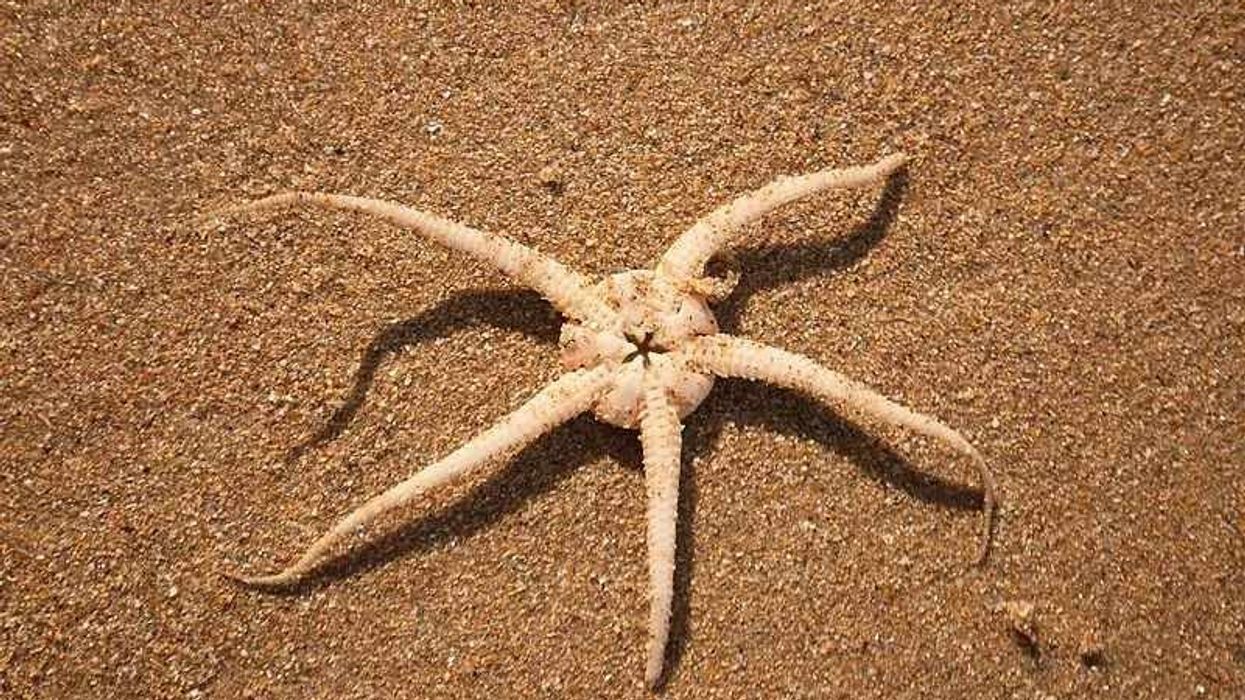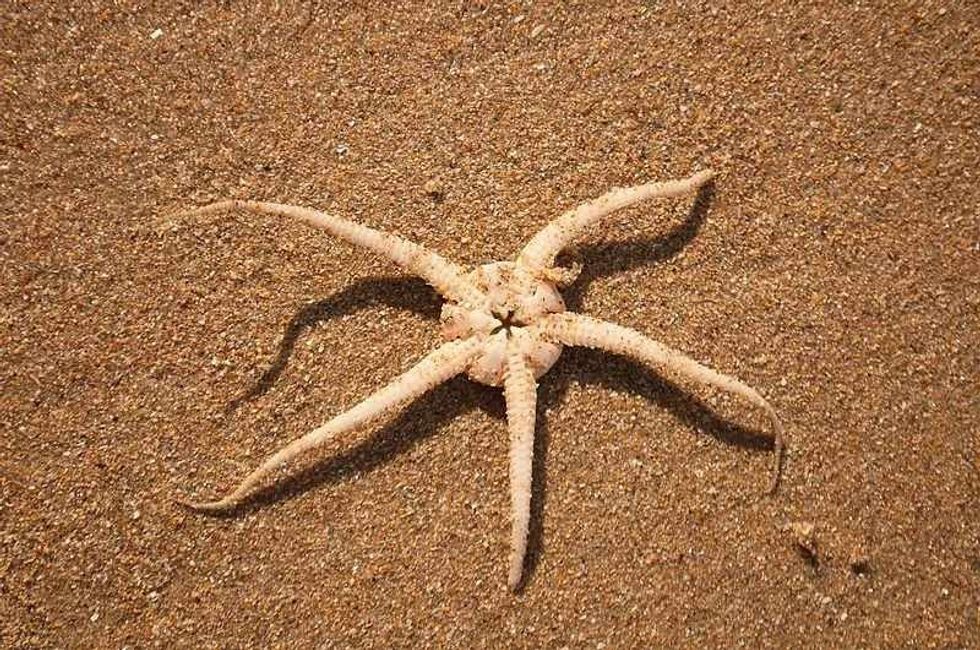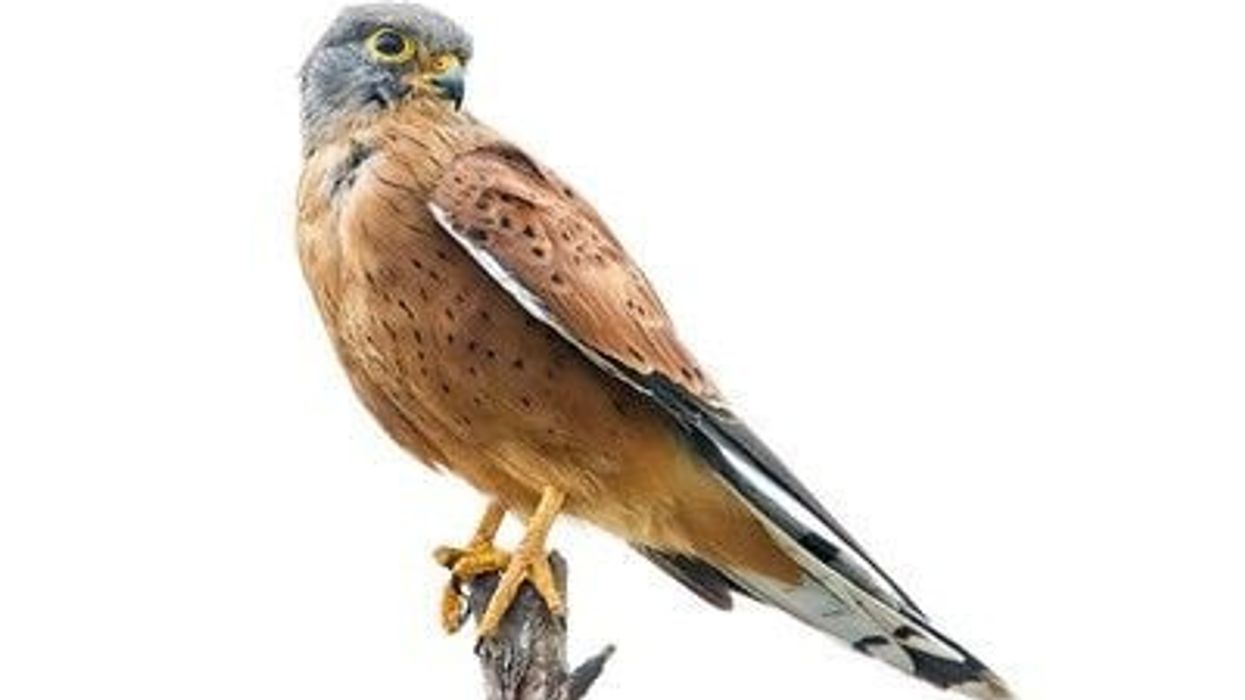Brittle Star (ophiothrix fragilis) is known as a serpent star or ophiuroid because of the five long arms connected to the central disk to help for movement along the sea floor. They belong to the family of echinoderms which are known for their radial symmetry like starfish, sea urchins, sand dollars, and sea cucumbers.
They have five slender, long whip-like arms, which are super flexible and help them move across the ocean floor. There are two large clades under the Ophiuroidea class which are Ophiurida or Brittle Star and Euryale or basket star.
There are over 2000 Brittle Star species found across the oceans of the earth. Out of which 1200 of them are deep water species found almost at a depth of 660 ft and below.
They have been around the planet for 500 million years now. Brittle stars are common members of reef communities.
This basket star is known to hide under rocks or even other animals, too. Their skeleton is made of embedded ossicles, which are small calcareous elements like sea urchins.
Brittle Stars (class ophiuroidea) are known to maintain their five-segment radial biological symmetry. The disk in the center is distinctively marked and contains all of the viscera. Their mouth is on the underside of the disk, which has five toothed jaws made of skeletal plates.
The mouth serves as an egestion and ingestion organ. Two of the best known species of Brittle Star are the green Brittle Star (ophioderma brevispina) and common European Brittle Star (ophiothrix fragilis). Brittle Star skeleton is made up of calcium carbonate.
After reading these interesting facts about species of Brittle Stars, do check our other articles on brain coral and hermit crab as well.
Brittle Star Interesting Facts
What type of animal is a Brittle Star?
Brittle Stars (class ophiuroidea) are marine animals that are closely related to starfish. They have five serpent-like arms attached to a distinct disk in the center of the body. There are over 2000 species of Brittle Star in the world.
What class of animal does a Brittle Star belong to?
The Brittle Star belongs to the class of ophiuroidea in the animal kingdom. Brittle Stars have a central disk at the middle of the body from which five long arms protrude that help this creature to move along the sea floor.
This creature also makes use of its arms to trap bacteria and plankton for its diet. The mouth of these sea stars comprises five jaws as serves as the anus as well.
How many Brittle Stars are there in the world?
The exact number of Brittle Stars is difficult to find due to their tiny size and varied species range. However, the IUCN has not listed these Basket Stars under endangered status, and it is assumed its population is stable and increasing. Their tube feet serve the primary purpose of being a sense organ used for detecting light.
Where does a Brittle Star live?
Brittle Stars are found near the shorelines of the British Isles. Sea Stars are also found along the coast bordering the North Sea and the eastern Atlantic Ocean as far as the Cape of Good Hope. Basket Stars are basically found through the coral reefs in oceans of the world in deep water and near the shorelines.
What is a Brittle Stars habitat?
The Brittle Star is found living in larger coral reef communities with many of its own species and other reef dwelling animals. These echinoderms are epifaunal (live on the surface of the seabed) and found living in large groups near the coast in what is called Brittle Star beds.
Sea Stars are also found alone in the intertidal zone. This marine animal prefers to live and walk on shell and sand bottoms and are found hiding under rocks or shells.
Basket Stars can be found on soft bottoms and rocky reefs, too.
In the depth of the ocean, they prefer places with strong currents as too much sedimentation can not let them find their food. Sedimentation also causes respiratory issues.
Who do Brittle Star live with?
The Brittle Star lives in large colonies known as Brittle Star beds. Sea Stars are active members of reef communities.
Brittles spend most of their time walking on the bottom of the sea or under other sea animals. These spiny marine creatures share the reef or rocky with other animals. In deep water they can be found on their own, too.
How long does a Brittle Star live?
The Brittle Star (class ophiuroidea) has a lifespan of 5-10 years. Not much is revealed and known about their lifespan in captivity.
How do they reproduce?
The male Brittle Star releases their sperm into the water, prompting the females to release their eggs. The eggs are thus fertilized and developed in a water column.
The spiny Brittle Star is known to breed all year round but they are most active sexually during the months of May to July. When their central disk reaches 10 mm in diameter they are considered to be sexually mature. They spawn once per breeding season.
They are known to be hermaphroditic and will change their sex during their lifetime. In the six-armed variety of Brittle Stars known as ophiactidae, they follow fissiparity, which is a splitting of their disk in half followed by regrowth of three arms in both individuals.
What is their conservation status?
The IUCN has not put Basket Stars in the Red List. Therefore, they fall in the category of Least Concern as it is assumed their population is stable and increasing. But the loss of their rocky or reef habitat and encroachment of the coastline could be a major concern for the declining population of Basket Stars.
Brittle Star Fun Facts
What does the Brittle Star look like?
The central body disk of a Brittle Star has five attached arms which are long and slim. The arms are five times the diameter of their body disk.
Their arms are segmented with tube feet and seven serrated spines per segment. There are spines on their disk, too. They are found in varied colors such as red, white, or brown.
How cute are they?
Brittle Stars are scrawny spiny creatures that may be odd looking according to many. But their build is what makes them unique in the sea world.
How do they communicate?
Limited information is available about their communication pattern, they are both vocal and non vocal. They are known to form their bed by interacting with other Brittle Stars and not on the basis of environmental conditions. During the breeding season, they may communicate using pheromones.
How big is a Brittle Star?
The Brittle Star is a tiny creature like echinoderms. Their arms grow to the length of 60 cm at most. They are smaller than the Basket Star.
How fast can Brittle Stars move?
Brittle Stars are known as the fastest echinoderms. They use their highly flexible arms to move across the ocean floor. They are known to swim by rowing their arms vigorously which looks as if they are doing the breast-stroke.
How much does a Brittle Star weigh?
The weight of a Brittle Star is between 0.1-0.3 oz. They are tiny creatures who are almost weightless due to the absence of a proper skeletal system.
What are the male and female names of the species?
Brittle Stars do not have specific names for their male and female species. They are known as male Brittle Stars and female Brittle Stars, respectively.
What would you call a baby Brittle Star?
Baby Brittle Stars are often called juveniles or just baby Brittle Stars.
What do they eat?
Brittle Stars are nocturnal passive suspension feeders. They lift their arms from a rock crevice to get the floating particles to its mouth from its arms.
They will use their vertical row of teeth along with a group of tooth papillae and two pairs of tube feet to eat food. They mostly eat diatoms, detritus, and phytoplankton. They are also scavengers looking for dead materials and small animals.
How did it get its name?
Their name comes from New Latin 'ophiurus' (Brittle Star) or from the Greek word 'ophis' which means serpent and oupa which is tail. This defines their name as serpent star or Brittle Star with a serpent’s tail like arms.
Would they make a good pet?
The Brittle Star is considered good tank mates with fish and corals. Since their behavior pattern is still quite unknown, along with their captivity details, they could be a cool addition to your aquarium, but it is best to do some research with experienced Brittle Star handlers.
Did you know...
Brittle Stars use their arms to move in a wriggling manner. They are bilaterally symmetrical, like humans, to move or swim away.
They are called Brittle Stars because their arms may break off easily when they are touched.
They do not have a brain system and function smartly for their feeding and protection.
What is another name for the Brittle Star?
Brittle Stars are also termed Serpent Star or ophiuroids.
How do Brittle Stars fight off predators?
The Brittle Star is prey to many species of fish and other sea creatures. Their cryptic coloring and hiding behavior under rocks, shells or other bigger animals save them from being preyed on.
Brittle Stars are nocturnal, which means they move out and feed during the night and hide during the day. They are known to lose their arms and regenerate them later, which distracts predators.
Here at Kidadl, we have carefully created lots of interesting family-friendly animal facts for everyone to discover! Learn more about some other arthropods including barnacle, or king crab.
You can even occupy yourself at home by drawing one on our Brittle star coloring pages.









